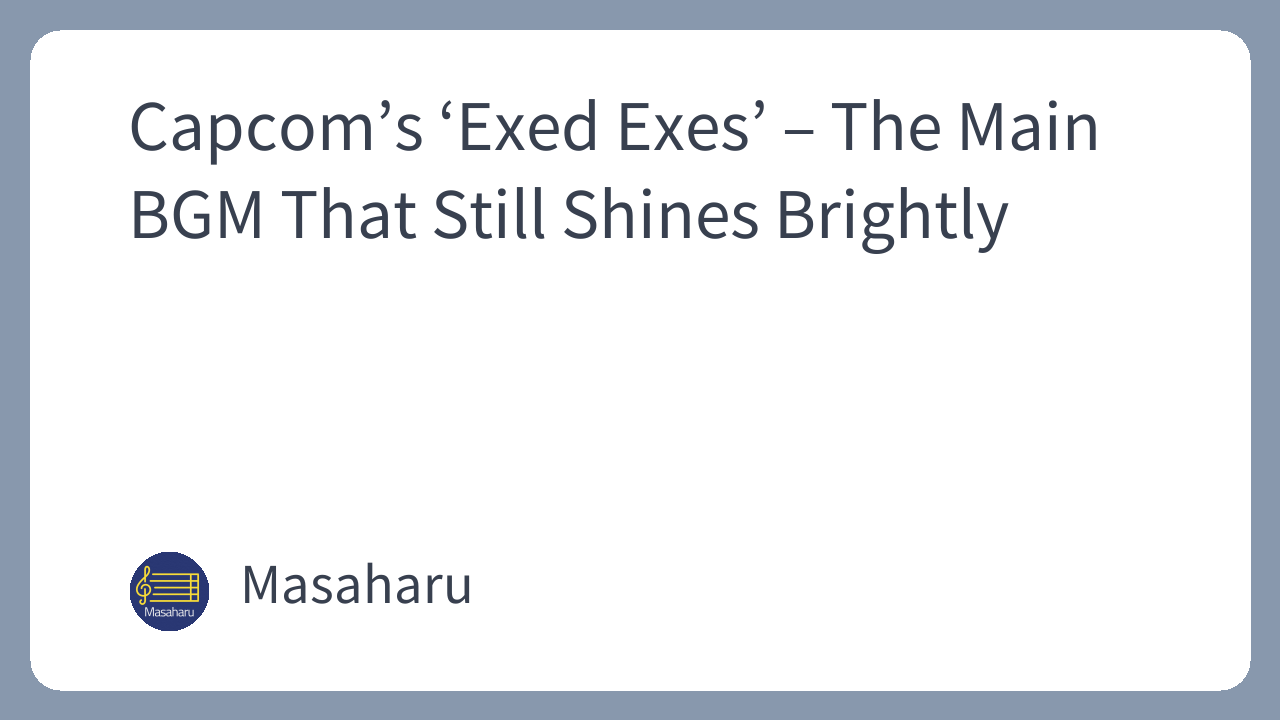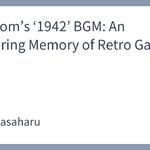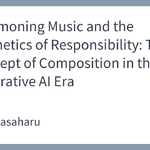Following up on my previous article about ‘1942’, I’d like to continue discussing the game music I loved back in the day, delving into its unique characteristics and appeal.
In this article, I will focus on the main BGM of Capcom’s ‘Exed Exes’, released in February 1985.
‘Exed Exes’ and its Unique Worldview
The game stood out with its highly original design, featuring insect-themed enemy characters and a battlefield landscape of interlocking hexagons reminiscent of a beehive. This created a distinct and unsettling “otherworldly” atmosphere with a dry, eerie quality. The giant floating fortresses that appeared at the climax of each stage left a powerful impression on players, combining intense bullet patterns with BGM that amplified the tension and sense of intimidation.
Notably, the game featured cooperative two-player simultaneous play, a rarity at the time. This introduced a new dimension of “collaborative fun” and “strategic depth” previously unseen in shooting games. Another major feature was the “Crash” defensive system, which allowed players to use an item called “Sakichi” to clear all enemy bullets from the screen. This emergency evasion mechanic can be seen as one of the precursors to the “bomb” systems in later shooting games. Furthermore, collecting a “Pow” item would transform all on-screen enemies into “fruit” bonus items, creating a scoring opportunity. This design choice arguably promoted the “high-score culture” that balanced risk and reward.
The Enchanting and Glistening Main BGM
When I first saw this game, I was immediately captivated by its unique world, from the fast-paced, multi-layered scrolling backgrounds to the metallic yet organic feel of the insect-themed designs. More than anything, however, I was instantly enthralled by the enchanting beauty of its main BGM. The striking arpeggio pattern, with its crystalline timbre descending non-functionally through semitones, resonated with me deeply and became unforgettable.
Please listen to the actual BGM in the video below.
Within a simple structure where four chords repeat every two measures, a harmony is built that evokes a sense of floating. It carries a mysterious ephemerality and a delicate lyricism.
The chord progression is as follows, a sequence that evades standard harmonic functions, making the tonic chord difficult to identify.
I△7→ VII7→ ♭VII△7→ ♭VI△7
IV△7→ III7→ ♭III△7→ ♭II△7
Since the entire piece is composed of arpeggiated chords (root + 3rd + 7th), it is impossible to strictly define a scale. Moreover, the absence of a functional harmonic cadence makes it difficult to assign a single tonality. These sounds, upon closer listening, reveal similarities to modern French music (Impressionism) and the jazz harmony that evolved from it.
Typically, the BGM for shooting games is designed to be heroic or aggressive, aiming to get the player’s adrenaline pumping to match the gameplay of dodging bullets and destroying enemies. ‘Exed Exes’, however, features a completely different aesthetic—a delicate, almost elegant arpeggio. This beautifully resonant BGM, so uncharacteristic of a shooting game, is truly exceptional. It is nothing short of brilliant how this music perfectly accentuates the game’s world from an auditory perspective. The “unsettling otherworldly atmosphere” mentioned earlier is arguably established and supported by this BGM, which was born from an aesthetic sensibility different from that of typical shooting game music.
The Precedent of ‘Xevious’
When I first heard this main BGM, I wondered if it was an homage to the BGM of ‘Xevious’. Namco’s legendary masterpiece ‘Xevious’ was released in late January 1983, two years before ‘Exed Exes’. It’s a classic vertical scrolling shooter set in near-future South America, where players fight against the invader Gump in a world full of mystery.
The BGM of ‘Xevious’ features an endlessly looping arpeggio pattern of four chords containing a chromatic descending line (cliché line). The superficial impression it leaves shares a commonality with ‘Exed Exes’.
However, the imagery evoked by the harmony in ‘Exed Exes’ is entirely different from that of ‘Xevious’. If the BGM of ‘Xevious’ could be described as “inorganic and mysterious,” the main BGM of ‘Exed Exes’ might be characterized as “transparent and dreamlike.” This leads to the speculation that the composer, Tamayo Kawamoto, may have been attempting to present a new direction for shooting game BGM—a shift from the “sci-fi/combat” of ‘Xevious’ to the “fantasy/otherworld” of ‘Exed Exes’.
If this is the case, it could be seen as more than a simple homage. It might be a “stylistic response” in the history of game music, a deliberate attempt to inherit and evolve the lineage of minimal BGM.
‘Exed Exes’ as a Milestone in Minimal BGM
“Minimal BGM,” characterized by the absence of a prominent melody, little to no musical development, and a structure built on the repetition of simple phrases, was not uncommon in games of this era. Even in the period between ‘Xevious’ and ‘Exed Exes’ (1983-1985), one can find various examples of minimal and compact BGM in games like Taito’s ‘Chack’n Pop’, Irem’s ‘Zippy Race’, ‘Spartan X’, and ‘Lot Lot’, and Namco’s ‘Dig Dug II’ and ‘Motos’.
By comparing ‘Exed Exes’ with these titles, its unique characteristics become clearer. Let’s examine the main BGM of a few of these games.
‘Chack’n Pop’ by Taito (1984)
The main BGM of ‘Chack’n Pop’ is constructed from an extremely simple motif repeating the tonic and dominant chords, effectively enhancing the game’s whimsical atmosphere. This “haiku-like BGM,” stripped of all excess, possesses a simplicity and high degree of perfection that feels like a return to the earliest forms of game music.
‘Spartan X’ by Irem (1984)
In ‘Spartan X’, only a bass riff pattern and rhythm are endlessly repeated over a blues progression. Lacking any melody or elaborate accompaniment, the style is literally “spartan” (rigorous and robust).
‘Dig Dug II’ by Namco (1985)
While the overall musical impression is completely different, it’s interesting to note that the bass part in ‘Dig Dug II’ shares a structural feature with ‘Xevious’ (though the pattern is slightly different, both have a descending chromatic cliché line). Since both games were composed by Yuriko Keino, this might have been an intentional playful touch.
‘Motos’ by Namco (1985)
The main BGM of ‘Motos’ places tense chords and arpeggios over a driving bass pattern, creating a musical space with a weak sense of tonality. At first listen, it evokes a sense of floating and dissonance, as if one’s footing is unstable. However, the bassline remains largely static, and when it does change, it maintains a strong relationship of fourths (which invert to fifths), achieving an exquisite overall balance. These musical elements perfectly match the gameplay of “push or be pushed off,” making it an excellent example of retro game BGM.
The Achievement of ‘Exed Exes’ Main BGM
All the retro games discussed here represent the best efforts and creative ideas within the developmental constraints of their time, demonstrating the intentional and effective use of minimal BGM. Even so, this examination reaffirms the uniqueness and forward-thinking nature of the ‘Xevious’ BGM and, above all, the refined and distinctive beauty of the ‘Exed Exes’ BGM.
As mentioned, ‘Exed Exes’ uses BGM born from a different aesthetic sensibility than previous shooting games to create, support, and accentuate its “unsettling, otherworldly atmosphere” from an auditory standpoint. In relation to ‘Xevious’, the possibility that it was more than just an homage—a “stylistic response” and a conscious attempt to inherit and evolve the lineage of minimal BGM—is a fascinating point of interest.
From this perspective, it is no exaggeration to say that the main BGM of ‘Exed Exes’ was a sophisticated pinnacle and a milestone of the “minimal BGM” of its era.
Memories of ‘Exed Exes’
I first played ‘Exed Exes’ at an arcade corner in my local bowling alley. Amidst the noisy environment, I could clearly hear its distinctive main BGM, but I recall not being able to make out the other tracks well.
I especially remember the fanfare after defeating a boss. For some reason, the bass frequencies felt overwhelmingly loud, and the rhythm pounded through. At the time, I was struck with awe, thinking, “This harmony, with its mysterious power and intimidating presence, is perfect for destroying a boss…!”
Later, when I heard it again in a different setting, I was confused: “Wait, was this the fanfare…?” Yet, the initial impression I had remains with me to this day, a faint but cherished “masterpiece in my heart.”
Related Articles




